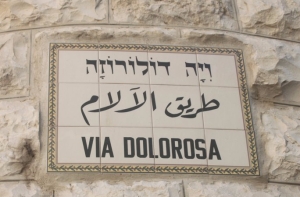 The Old City in Jerusalem is chockablock with thin places.
The Old City in Jerusalem is chockablock with thin places.
Countless worship and pilgrimage sites for the three Abrahamic faiths are packed within one square kilometer.
I find it all overwhelming. For the most part I have not experienced the transcendent power of being in a thin place when I am in the Old City.
There is one exception to this.
My academic training is as an historian. Retracing the steps of historic figures, reading original documentary evidence, and visiting places where history is authentically present thrills me. I’m always in search of that nugget of evidence that supports the narrative.
However, peeling away the layers and imagining Jerusalem as it was when specific events took place is not always easy. I find it can sometimes be difficult to access the sense that any of the Christian narrative is real or true. At the same time, I have always been fascinated with the historical Jesus.
I recently had occasion to consult Reza Aslan’s masterful book, Zealot: The Life and Times of Jesus of Nazareth. Aslan brilliantly lays out the case for understanding Jesus as an historical figure, not the divine one that is as the center of Christianity.
Ironically, understanding Jesus as an historical figure strengthens my belief in his divinity. Thus, when I am in the Old City, I am always on the lookout for signs of the historical Jesus.
No Christian pilgrimage to Jerusalem is complete without walking the Via Dolorosa. The route traces the path that Jesus of Nazareth walked to his crucifixion by the Romans. The current Via Dolorosa passes by the Ecce Homo Pilgrim House.
It is beneath Ecce Homo that I experienced my most profound encounter with the historical record of Jesus’ life.
One day, after lunch at the Pilgrim House, my guide took me to an almost hidden stairway leading to the basement. There excavations have revealed ancient Roman paving stones known as Lithostrotos. These stones are believed to have come from the Antonia Fortress, which is associated with Pontius Pilate and Jesus’ trial, over which he presided.
However, it is not the stones per se that brought me closest to the historical Jesus. It is the ancient Roman game boards are carved on them.
The Gospel of Matthew recounts that as Jesus is being crucified by the Romans, soldiers cast lots to divide up his clothes.
As I contemplated the stones, the hair on the back of my neck stood up.
Two millennia ago Roman soldiers were using these stones to play games and gamble, quite possibly over Jesus’ clothing. The details in Matthew’s narrative are, to my mind, corroborated by the markings on these paving stones along the Via Dolorosa.
At last, I was in a thin place that cut through the cacophony of the Old City’s hustle and bustle.
I began to weep.
Photo shared under a Creative Commons Attribution-Share Alike license. Photo by Peter van der Sluijs.
Dear Rob…
I had a similar experience when I saw the stones with the game markings.
They represented to me so clearly the suffering Jesus was experiencing and the humanness of the people causing the suffering. The game players were exhibiting an indifference that I believe is the real sin in the lives of most of the human race….the I am not looking, connecting with or caring about what is happening across the threshold of my church, my community or the world.
The humanness of the moments for Jesus and the system crucifying him were so obvious to me as I traveled along “the way” in Jerusalem.
LikeLike
Thank you for sharing this touching account.
LikeLike